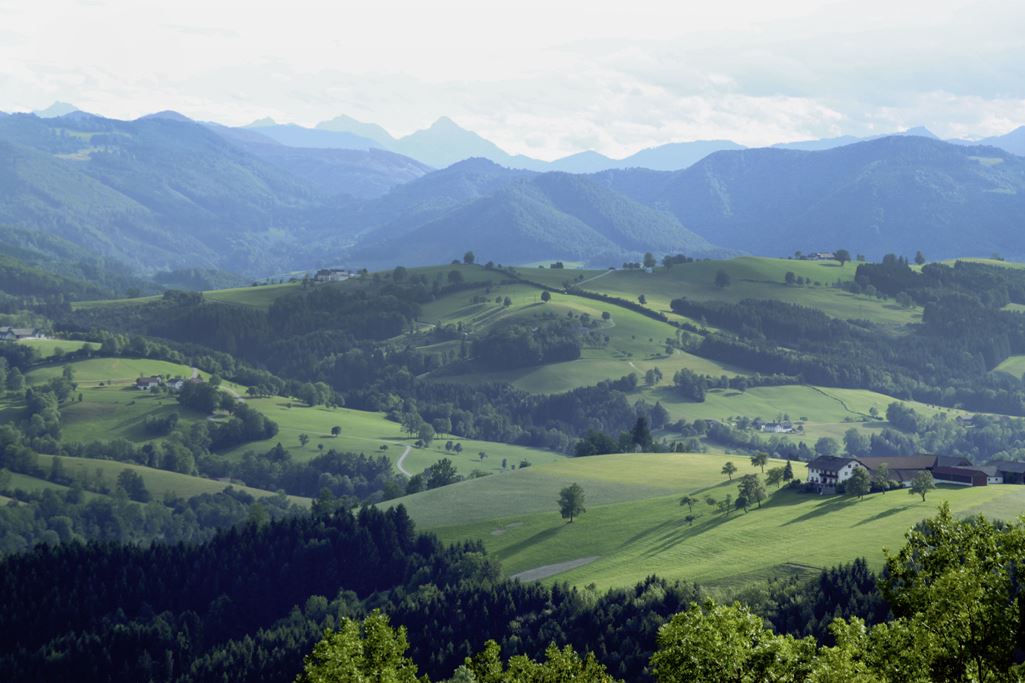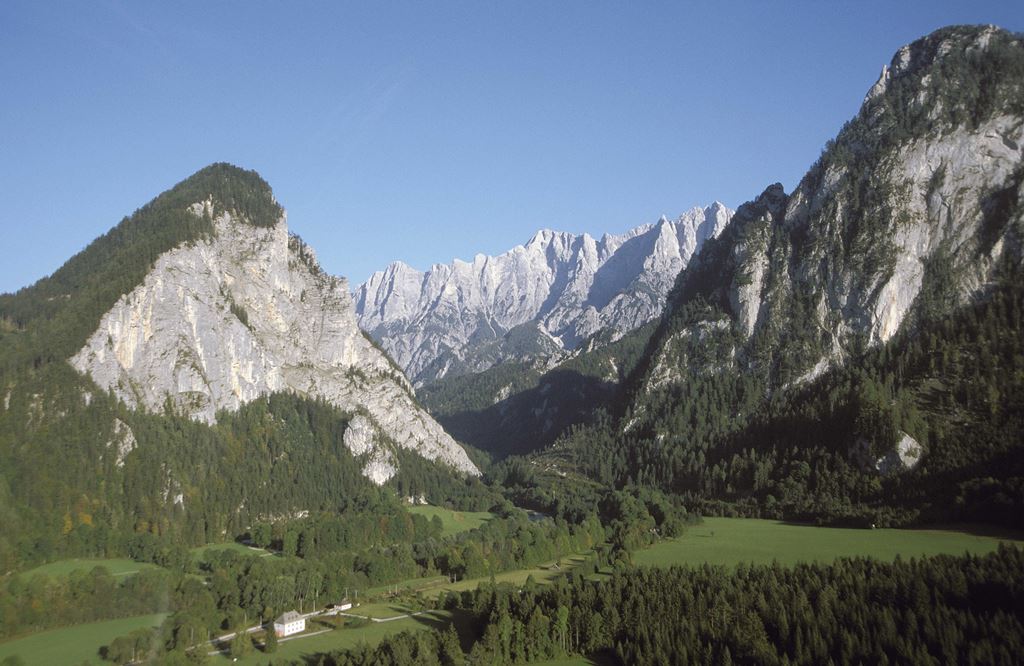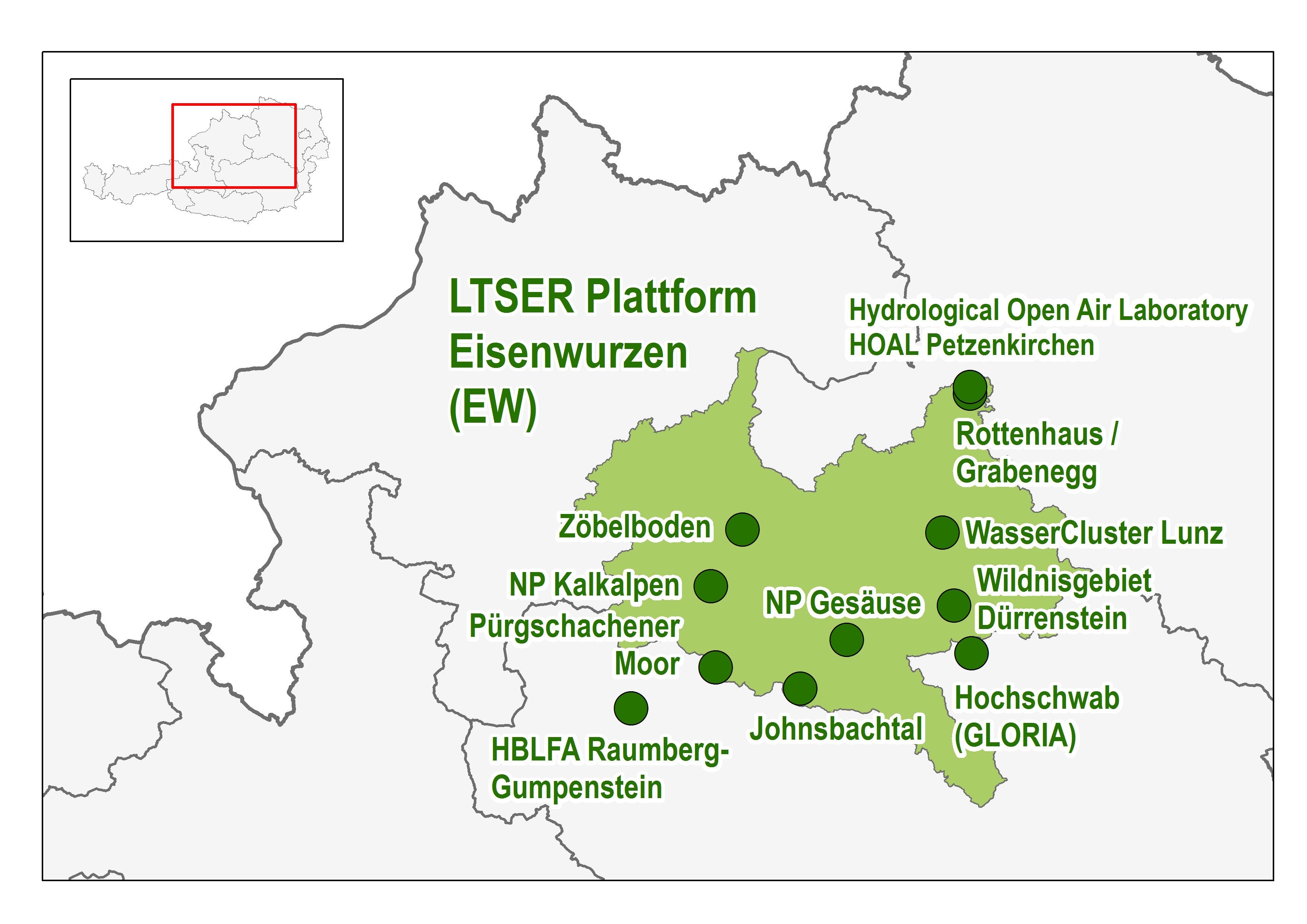LTSER Platform Eisenwurzen (Regular)
Operator: Environment Agency Austria (Umweltbundesamt GmbH)
Funding body: Austrian Academy of Sciences (ÖAW)
DEIMS-SDR Database: Eisenwurzen
Contact: Andrea Stocker-Kiss and Michael Mirtl
Site description
The LTSER platform Eisenwurzen represents both a natural space and a historically developed social and economic area. It does not correspond exactly to federal county borders but extends over 91 municipalities and a total area of 5,904 km2 in the counties of Upper Austria, Lower Austria and Styria. 80 % of the LTSER platform are part of the Northern Alps, 11 % of the area belong to the Northern Alpine Foothills and 9 % belong to the Central Alps. Altitudes range from 167 to 2,515 m a.s.l. The climate type is Continental. Depending on local conditions, annual precipitation values between 730 mm and 2,202 mm are measured. The annual mean temperatures range from -0.8 °C to 9.14 °C.


The LTSER Platform Eisenwurzen was established in 2004. A network of institutions already working in the region (universities, national parks, research centers, etc.) and high-quality documentation (data material) provide good prerequisites for the first Austrian LTSER platform. The LTSER platform Eisenwurzen includes twelve LTER sites – Feldbach-WegenerNet, HBLFA Raumberg-Gumpenstein, Hochschwab GLORIA, HOAL Petzenkirchen, Johnsbach Valley, Gesäuse National Park, Kalkalpen National Park, Pürgschachen Moor, Rottenhaus/Grabenegg, WasserCluster Lunz, Wildnisgebiet Dürrenstein and Zöbelboden – covering a variety of habitat types (grasslands, woodlands, fresh water habitats, …).

Research institutions and regional institutions, decision-making bodies and regional management participate actively in the research platform. On one hand, scientists work on sociological and natural science themes in cross-disciplinary teams and in close cooperation with regional populations and their representatives. On the other hand, regional research questions are formulated and – as far as possible - integrated into research agendas. The project results build the basis for sustainable ecosystem management and preservation as well as sustainable regional development.
The research projects are located in the following areas:
- Basic ecosystem research: e.g. at the site Zöbelboden, where long-term monitoring has been carried out into the forest ecosystem on calcareous bedrock;
- Applied biodiversity and conservation research: e.g. investigation into the impacts of increased forestation upon biodiversity brought about by the retreat of human activity;
- Socio-ecological research: e.g. the Reichraming project, in which a participatively-developed integrated model shows what impacts both internal and external factors have upon material flows, community structure and agriculture;
The Eisenwurzen LTSER platform is part of the European long-term research network LTER-Europe. In the framework of LTER-Europe, a network is being established of 40 LTSER platforms carrying out exemplary research into the natural and inhabited areas (socio-ecological regions) of Europe.
Publications
- Angelstam P., Manton M., Elbakidze M., Sijtsma F., Adamescu M.C., Avni N., Beja P., Bezak P., Zyablikova I., Cruz F., Bretagnolle V., Diaz-Delgado R., Ens B., Fedoriak M., Flaim G., Gingrich S., Lavi-Neeman M., Medinets S., Melecis V., Munoz-Rojas J., Schäckermann J., Stocker-Kiss A., Setälä H., Stryamets N., Taka M., Tallec G., Tappeiner U., Törnblom J., Yamelynets T. (2019): LTSER platforms as a place-based transdisciplinary research infrastructure: learning landscape approach through evaluation. Landscape Ecol 34, 1461–1484 (2019). https://doi.org/10.1007/s10980-018-0737-6
- Dick J,. Orenstein D. E., Holzer J. M., Wohner C., Achard A.-L., Andrews C., Avriel-Avni N., Beja P., Blond N., Cabello J., Chen C., Díaz-Delgado R., Giannakis G. V. , Gingrich S., Izakovicova Z., Krauze K., Lamouroux N., Leca S., Melecis V., Kertész M., Mimikou M., Niedrist G., Piscart C., Postolache C., Psomas A., Santos-Reis M., Tappeiner U., Vanderbilt K., Van Ryckegem G. (2018): What is socio-ecological research delivering? A literature survey across 25 international LTSER platforms. Science of the Total Environment 622 – 623 (2018) 1225 – 1240, Elsevier B.V. https://doi.org/10.1016/j.scitotenv.2017.11.324
- Gingrich, S.; Schmid, M.; Dirnböck, T.; Dullinger, I.; Garstenauer, R.; Gaube, V.; Haberl, H.; Kainz, M.; Kreiner, D.; Mayer, R.; Mirtl, M.; Sass, O.; Schauppenlehner, T.; Stocker-Kiss, A.; Wildenberg, M. (2016): Long-Term Socio-Ecological Research in Practice: Lessons from Inter- and Transdisciplinary Research in the Austrian Eisenwurzen. Sustainability 2016, 8, 743.
- Garstenauer R., Tod S. (2014): Ideal und Pragmatik: Die Resilienzstrategien zweier Kleinbetriebe in Niederösterreich. In: Land-Berichte Bd. 9, Aachen 2014, 57 - 76.
- Dirnböck T., Bezák P., Dullinger S., Haberl H., Lotze-Campen H., Mirtl M., Peterseil J., Redpath S., Singh S.J., Travis J., Wijdeven S.M.J. (2013): Critical Scales for Long-Term Socio-ecological Biodiversity Research. In: Singh S.J., Haberl H., Chertow M., Mirtl M., Schmid M. (Eds.). Long Term Socio-Ecological Research. Studies in Society: Nature Interactions Across Spatial and Temporal Scales. Series: Human-Environment Interactions, Vol. 2, 123-138. Springer. ISBN 978-94-007-1176-1. DOI 10.1007/978-94-007-1177-8_6
- Gaube V., Haberl H. (2013): Using Integrated Models to Analyse Socio-ecological System Dynamics in Long-Term Socio-Ecological Research - Austrian Experiences. In: S.J. Singh et al. (eds.), Long Term Socio-Ecological Research, Human-Environment Interactions 2, DOI 10.1007/978-94-007-1177-8_3, Springer, Dordrecht 2013.
- Gingrich S., Schmid M., Gradwohl M., Krausmann F. (2013): How Material and Energy Flows Change Socio-natural Arrangements: The Transformation of Agriculture in the Eisenwurzen Region, 1860-2000. In: S.J. Singh et al. (eds.), Long Term Socio-Ecological Research, Human-Environment Interactions 2, DOI 10.1007/978-94-007-1177-8_13, Springer, Dordrecht 2013.
- Haberl H., Erb K.-H., Gaube V., Gingrich S., Singh S.J. (2013): Socioeconomic Metabolism and the Human Appropriation of Net Primary Production: What Promise Do They Hold for LTSER? In: S.J. Singh et al. (eds.), Long Term Socio-Ecological Research, Human-Environment Interactions 2, DOI 10.1007/978-94-007-1177-8_2, Springer, Dordrecht 2013.
- Mirtl M., Orenstein D.E., Wildenberg M., Peterseil J., Frenzel M. (2013): Development of LTSER Platforms in LTER-Europe: Challenges and Experiences in Implementing Place-Based Long-Term Socio-ecological Research in Selected Regions. In: Singh S.J., Haberl H., Chertow M., Mirtl M., Schmid M. (Eds.). Long Term Socio-Ecological Research. Studies in Society: Nature Interactions Across Spatial and Temporal Scales. Series: Human-Environment Interactions, Vol. 2, 409-442. Springer. ISBN 978-94-007-1176-1
- Mirtl M., Orenstein D.E., Wildenberg M., Peterseil J., Frenzel M. (2013): Development of LTSER Platforms in LTER-Europe: Challenges and Experiences in Implementing Place-Based Long-Term Socio-ecological Research in Selected Regions. In: S.J. Singh et al. (eds.), Long Term Socio-Ecological Research, Human-Environment Interactions 2, DOI 10.1007/978-94-007-1177-8_17, Springer, Dordrecht 2013.
- Peterseil J., Neuner A., Stocker-Kiss A., Gaube V., Mirtl M. (2013): The Eisenwurzen LTSER Platform (Austria) - Implementation and Services. In: S.J. Singh et al. (eds.), Long Term Socio-Ecological Research, Human-Environment Interactions 2, 641-484. Springer. ISBN 978-94-007-1176-1. DOI 10.1007/978-94-007-1177-8_19
- Singh S.J., Haberl H., Chertow M., Mirtl M., Schmid M. (Eds.) (2013): Long Term Socio-Ecological Research. Studies in Society: Nature Interactions Across Spatial and Temporal Scales. Series: Human-Environment Interactions, Vol. 2, 544 p. Springer. ISBN 978-94-007-1176-1
- Garstenauer R., Schwarz U., Tod S. (2012): Alles unter einen Hut bringen. Bäuerliche Wirtschaftsstile in zwei Regionen Niederösterreichs 1945–1985. In: Historische Anthropologie 20 (2012) Heft 3, 383-426.
- Garstenauer R., Tod S. (2012): Akteure des „Strukturwandels“. Bäuerliche Wirtschaftsstile in zwei Regionen Niederösterreichs 1945-2010. In: Tagungsbericht über den 26. Österreichischer Historikerinnen- und Historikertag, 24—28.9. 2012, Krems, St. Pölten 2015, 206 - 215.
- Langthaler E., Tod S., Garstenauer R. (2012): Wachsen, Weichen, Weitermachen. Familienbetriebliche Agrarsysteme in zwei Regionen Niederösterreichs 1945-1985. In: Historische Anthropologie 20 (2010) Heft 3, 346-382.
- Schauppenlehner, T; Amon, H (2012): Landschaftskulissen – ein GIS-basierter Ansatz zur Analyse der räumlichen Landschaftsstruktur und Bewertung landschaftsästhetischer Aspekte. In: Strobl, J; Blaschke, T; Griesebner, G (Hrsg.), Angewandte Geoinformatik 2012: Beiträge zum 24. AGIT-Symposium Salzburg.
- Schönhart, M., Schauppenlehner, T., Schmid, E. (2011): Integrated Bio-Economic Farm Modeling for Biodiversity Assessment at Landscape Level . In: Flichman, G. (ed.), Bio-Economic Models applied to Agricultural Systems 2, 185-213; Springer Science+Business Media B.V. , Dordrecht, Heidelberg, London, New York; ISBN 978-94-007-1902-6_10.
- Schönhart, M; Schauppenlehner, T; Schmid, E; Muhar, A (2011): Analysing the maintenance and establishment of orchard meadows at farm and landscape levels applying a spatially explicit integrated modelling approach. J ENVIRON PLAN MANAG. 54(1): 115-143.
- Schönhart, M; Schauppenlehner, T; Schmid, E; Muhar, A (2011): Integration of bio-physical and economic models to analyze management intensity and landscape structure effects at farm and landscape level. AGR SYST. 104(2): 122-134. WoS FullText FullText_BOKU.
- Garstenauer R. (2010): Der kurze und der lange Weg in die Moderne. Zwei autobiographische Fallstudien ehemaliger Landarbeiter/-innen, in: Österreich in Geschichte und Literatur Jg. 54 (2010) 2, 100 - 109.
- Haberl H., FischerKowalski M., Krausmann F., MartinezAlier J., Winiwarter V. (2010): A sociometabolic transition towards sustainability? Challenges for another Great Transformation. Sustainable Development (online first: doi: 10.1002/sd.410)
- Mirtl, M., Bahn, M., Battin, T., Borsdorf, A., Englisch, M., Gaube, V., Grabherr, G., Gratzer, G., Haberl, H., Kreiner, D., Richter, A., Schindler, S., Tappeiner, U., Winiwarter, V., Zink, R., (2010): „Next Generation LTER“ in Österreich - Zu Lage und Ausrichtung von prozessorientierter Ökosystemforschung, Biodiversitäts- und Naturschutzforschung sowie sozio-ökologischer Forschung in Österreich. LTER-Austria Schriftenreihe, Vol. 1, ISBN 978-3-901347-94-8.
- Schauppenlehner, T., Schönhart, M., Muhar, A., Schmid, E. (2010): Landschaftsstruktur in der Landnutzungsmodellierung: GIS-basierte Analyse zur Bewertung von Biodiversität und Landschaftsästhetik in Kulturlandschaften am Beispiel von Streuobst . In: Strobl, J. Blaschke, T. & Griesebner, G. (Hrsg.), Angewandte Geoinformatik 2010, Beiträge zum 22. AGIT-Symposium Salzburg, Wichmann-Verlag, Heidelberg.
- Singh S. J., Haberl H., Gaube V., Grünbühel C.M., Lisievici P., Lutz J., Matthews R., Mirtl M., Vadineanu A., Wildenberg M. (2010): Conceptualising LongTerm Socioecological Research (LTSER): Integrating the Social Dimension. In: Felix Müller, Cornelia Baessler, Hendrik Schubert, Stefan Klotz (Eds.). LongTerm Ecological Research, Between Theory and Application. Springer, Dordrecht, Heidelberg, London, New York, 377398.
- Erb K.H., Krausmann F., Gaube V., Gingrich S., Bondeau A., FischerKowalski M., Haberl H. (2009): Analyzing the global human appropriation of net primary production – processes, trajectories, implications. An introduction Ecological Economics 69(2), 250259. (doi: 10.1016/j.ecolecon.2009.07.001)
- Gaube, V., Kaiser, C., Wildenberg, M., Adensam, H., Fleissner, P., Kobler, J., Lutz, J., Schaumberger, A., Schaumberger, J., Smetschka, B., Wolf, A., Richter, A., Haberl, H. (2009): Combining agent-based and stock-flow modelling approaches in a participative analysis of the integrated land system in Reichraming, Austria. Landscape Ecology, 24, 1149-1165. (doi: 10.1007/s10980-009-9356-6)
- Haberl, H., Gaube, V., Díaz-Delgado, R., Krauze, K., Neuner, A., Peterseil, J., Plutzar, C., Singh, S.J., Vadineanu, A. (2009): Towards an integrated model of socioeconomic biodiversity drivers, pressures and impacts. A feasibility study based on three European long-term socio-ecological research platforms. Ecological Economics 68(6), 1797-1812. (doi: 10.1016/j.ecolecon.2008.11.013)
- Krausmann F., Gingrich S., Eisenmenger N., Erb K.H., Haberl H., FischerKowalski M. (2009): Growth in global materials use, GDP and population during the 20th century. Ecological Economics 68(10), 26962705. (doi: 10.1016/j.ecolecon.2009.05.007)
- Dirnböck T., Bezák P., Dullinger S., Haberl H., LotzeCampen H., Mirtl M., Peterseil J., Redpath S., J. Singh S. J, Travis J., Wijdeven S. (2008): Scaling issues in longterm socioecological biodiversity research: A review of European cases. Social Ecology Working Paper 100. IFF Social Ecology, Vienna"
- Dirnböck, T., Bezák, P., Dullinger, S., Haberl, H., Lotze-Campen, H., Michael Mirtl, Peterseil, J., Redpath, S., J. Singh, S. J, Travis, J., Wijdeven, S. (2008): Scaling issues in long-term socio-ecological biodiversity research: A review of European cases. Social Ecology Working Paper 100. IFF Social Ecology, Vienna.
- Erb K.H., Gingrich S., Krausmann F., Haberl H. (2008): Industrialization, Fossil Fuels and the Transformation of Land Use: An Integrated Analysis of Carbon Flows in Austria 18302000 Journal of Industrial Ecology 12(56), 686703. (doi: 10.1111/j.15309290.2008.00076.x).
- Garstenauer R. (2008): Ungleiches Wirtschaften. Die Entwicklung der Landwirtschaft in verschiedenen Regionen Niederösterreichs, in: Peter Melichar, Stefan Eminger und Ernst Langthaler (Hg.): Niederösterreich im 20. Jahrhundert, Bd. 3: Wirtschaft in der Gesellschaft, Wien 2008, 219 - 260.
- Newig J., Gaube V., Berkhoff K., Kaldrack K., Kastens B., Lutz J., Schlußmeier B.K., Adensam H., Haberl H. (2008): The role of formalisation, participation and context in the success of public involvement mechanisms in resource management. Systemic Practice and Action Research 21(6), 423441.( doi: 10.1007/s1121300891139).
- Newig J., Haberl H., PahlWostl C., Rothman D. (2008): Formalised and NonFormalised Methods in Resource Management, Knowledge and Learning in Participatory Processes. Systemic Practice and Action Research 21(6), 381387. (doi: 10.1007/s112130089112x).
- Dearing J. A., Graumlich L.J., Grove R., Grübler A., Haberl H., Hole F., Pfister C., van der Leeuw S.E. (2007): Integrating socioenvironment interactions over centennial timescales: needs and issues. In: Costanza, R., Graumlich, L.J., Steffen, W. (eds.) Sustainability or Collapse? An Integrated History and Future of People on Earth. The MIT Press, Cambridge, MA, London, UK, 243274.
- Erb K.H., Haberl H., Krausmann F. (2007): The fossil fuelpowered carbon sink. Carbon flows and Austria's energetic metabolism in a longterm perspective. In: FischerKowalski, M., Haberl, H. (eds.) Socioecological transitions and global change. Edward Elgar, Cheltenham, 6082.
- FischerKowalski M., Haberl H. (eds.)(2007): Socioecological Transitions and Global Change. Trajectories of Social Metabolism and Land Use. Edward Elgar, Cheltenham, UK and Northampton, USA.
- FischerKowalski M., Haberl H.(2007): Conceptualizing, observing and comparing socioecological transitions. In: FischerKowalski, M., Haberl, H. (eds.) Socioecological transitions and global change. Edward Elgar, Cheltenham, 130.
- FischerKowalski M., Haberl H., Krausmann F. (2007): Conclusions: Likely and unlikely pasts, possible and impossible futures. In: FischerKowalski, M., Haberl, H. (eds.) Socioecological transitions and global change. Edward Elgar, Cheltenham, 223255.
- Garstenauer R. (2007): Gebrochen und wiederhergestellt. Kontinuität in den Autobiografien ehemaliger Landarbeiterinnen und Landarbeiter, in: Kift Dagmar, Palm Hanneliese (Hg.): Arbeit - Kultur - Identität. Zur Transformation von Arbeitslandschaften in der Literatur, Essen 2007 (= Schriften des Fritz-Hüser-Instituts für deutsche und ausländische Arbeiterliteratur Bd. 15) 189 - 204.
- Gingrich S., Erb K.H., Krausmann F., Gaube V., Haberl H. (2007): Longterm dynamics of terrestrial carbon stocks in Austria. A comprehensive assessment of the time period from 1830 to 2000. Regional Environmental Change 7(1), 3747. (doi:10.1007/s1011300700246).
- Haberl H., Krausmann F. (2007): The local base of the historical agrarianindustrial transition, and the interaction between scales. In: FischerKowalski, M., Haberl, H. (eds.) Socioecological transitions and global change. Edward Elgar, Cheltenham, 116138.
- Krausmann F., Haberl H. (2007): Landuse change and socioeconomic metabolism: a macro view of Austria 18302000. In: FischerKowalski, M., Haberl, H. (eds.) Socioecological transitions and global change. Edward Elgar, Cheltenham, 3159.


